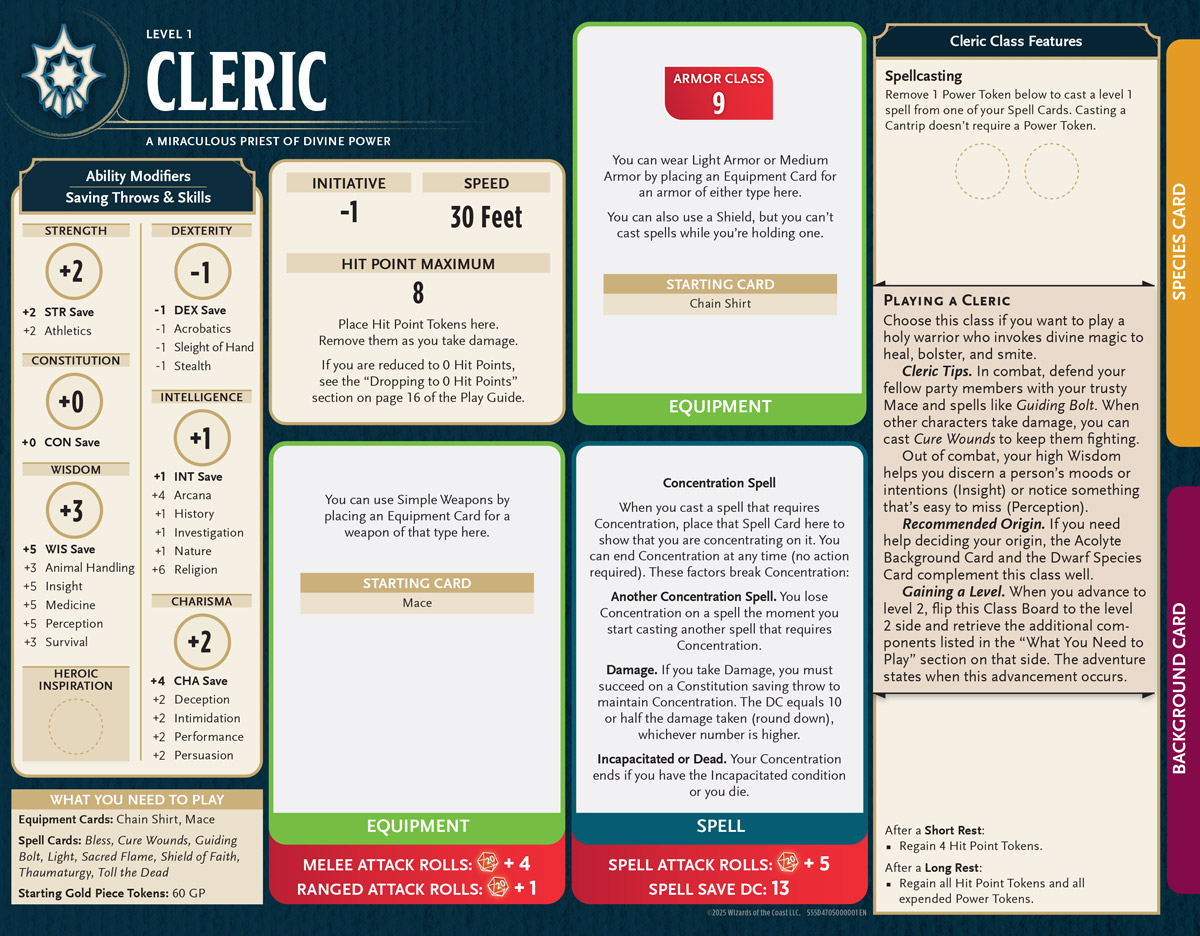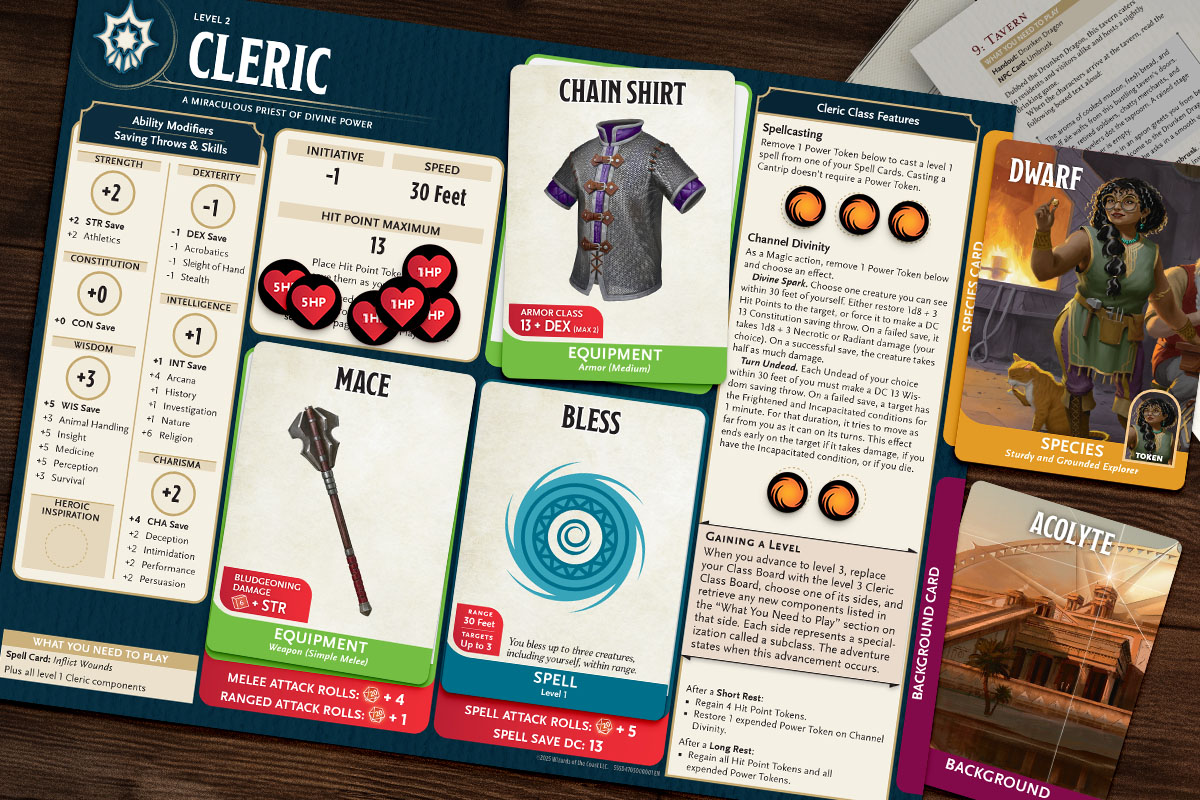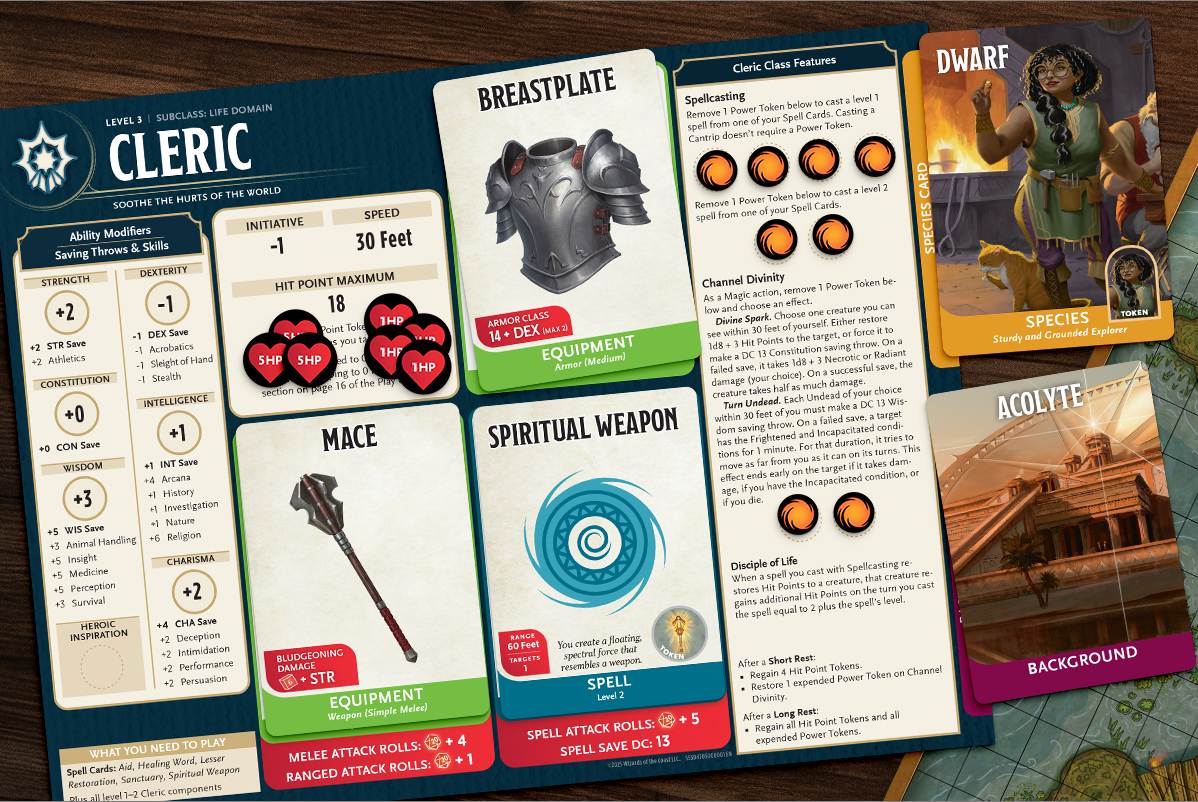When you open the Heroes of the Borderlands box, one of the first treasures you'll discover are the class boards. These are your gateway into the role of a hero, designed to combine the imagination of Dungeons & Dragons with the ease of use of a board game. Each board is a dashboard that clearly lays out everything you need to play, from your Armor Class to your spells and features, with card slots and token trackers that keep the game moving fast.
Let's explore how these boards make introducing new players to D&D smoother, faster, and more fun than ever before!
The Anatomy of a Class Board

Every class in Heroes of the Borderlands has its own board, but they share a similar layout so that new players can quickly find what matters. Let's break down the core sections:
Everything You Need to Get Rolling on Adventures
Each board is built so you can sit down, sort out a few cards, and start adventuring. The essential rules of your class are presented front and center, while the gear and gold you start with are listed in a tidy checklist.
- Ability Modifiers. The six core abilities—Strength, Dexterity, Constitution, Intelligence, Wisdom, and Charisma—dictate your character's strengths. Modifiers are pre-calculated and printed, so you can jump right into play with everything you need to make checks, saves, and attacks with zero prep.
- Saving Throws and Skills. These sections seamlessly include your proficiencies to highlight where your hero shines.
- What You Need to Play. This checklist shows which cards and tokens you'll need for your class. For example, the Cleric begins with a Chain Shirt, a Mace, a suite of staple spells like Bless and Cure Wounds, and 60 GP.
- Playing Your Class. You'll also receive guidance on both the fantasy of the class and the strategy behind it. This includes recommended origin cards to help streamline character creation as much as possible.
Combat and Class Features at a Glance
When it's time to draw steel or let spells fly, you won't need to go flipping through pages—everything you need to know about what your character can do is laid out in front of you.
- Initiative, Speed, and Hit Points. These trackers streamline combat. Tokens for Hit Points are a physical component, so losing tokens feels more like your character is fighting to stay standing.
- Attacking. Need to cast an offensive spell or swing your sword? Everything you need is prominently displayed alongside an icon for which dice you need to roll.
- Card Spaces. Clearly marked slots show where to place armor, origin, spell, and weapon cards. This keeps your table neat and helps you understand where your abilities are coming from and how to use them.
Bite-Sized Learning
Veteran D&D players will notice that these class boards slightly bend character creation and play rules to skirt around the more in-the-weeds details. This is done intentionally to help make onboarding as straightforward as possible.
For instance, you'll see that the section on Short Rest doesn't say anything about rolling Hit Point Dice; just that the character automatically receives 4 Hit Points after a Short Rest.
Similarly, the board doesn't mess around with describing components and weapon juggling to cast spells. It simply states, "You can also use a Shield, but you can't cast spells while you're holding one."
Growing with Your Hero
These boards evolve with your character. As you level up, discover new gear, and grow your abilities, your play surface changes in ways you can feel.
Level 2: A Burgeoning Hero

Each character's starting board is double-sided. When you level up to level 2, you flip the board over. The reverse side updates your Hit Points, adds new features, and expands your options without adding complexity. It's a smooth, tactile way to mark your growth.
Level 3: Specializing Your Role

At level 3, you swap your board for one tailored to your subclass choice. For the Cleric, you choose between the Life Domain and the Light Domain. The Life board emphasizes healing, durability, and protection, while the Light board unlocks radiant power and fiery spells that burn away the dark.
Every character receives new and unique powers at this milestone, and the boards reflect that choice clearly with new spells or subclass features printed right where you need them.
Designed for Play, Not Paperwork
These boards serve as an introduction to what used to be an intimidating character sheet with an easy-to-read play surface. Tokens, cards, and dedicated spaces all work together like a living rulebook and prepare players for the experience of a full character sheet when they're ready.
For new players, this means Heroes of the Borderlands can enable faster learning and more fun. For veterans, it means more friends and family members to play with, fewer interrupting rule lookups, and more time telling stories!

Mike Bernier is the founder of Arcane Eye, a site focused on providing useful tips and tricks to all those involved in the world of D&D. Outside of writing for Arcane Eye, Mike spends most of his time playing games, hiking with his partner, and tending the veritable jungle of houseplants that have invaded his house.








-
View User Profile
-
Send Message
Posted Oct 29, 2025Is it possible to print these boards? I bought both the box and the electronic version. What if I have players that want to be the same class?
I would really appreciate anyone who has a source for printing out new boards and cards.
-
View User Profile
-
Send Message
Posted Oct 30, 2025BECMI was set up as a tutorial. Each new boxed set introduced new rules and environmental play mechanics. For instance, the first set taught you how to play in a dungeon. The Expert set introduced rules and play for wilderness adventuring- basically survival play and hex exploration. Next was the Dominion category of play introduced in the Companion set, with the best war rules for large scale combat ever printed- War Machine! The next set, Masters, delved deeply into extraplanar games and becoming an immortal. The Immortal set was how to play as an immortal, basically a god. (That was where we hung up our cloaks back in the day.)
It should be noted that Basic went to level 36 with epic play considered just another step in the game. Epic adventures were more RP heavy and like a tactical game. It was great fun!
My point is I don't think the separate boxes were that big an issue as far as ruleset was concerned. The boxed sets were supposed to build on the previous set, not supplant them, and I don't remember a set changing the rules, just adding to them.
With this in mind I think a version of the game that uses boxed sets would be great for new players- I think I understood more of the mechanics of the game than mo0st of the people I've played with because of my time playing "Basic". I also want everyone who reads this to know that "Basic" is a misnomer- this version of the game was probably more complex than the current version or even back to 3rd, not counting the character options. The weapon mastery system, for instance, and the rules for dominions have not been re-introduced as a core part of the game. Weapon Mastery and training was much more rewarding, and we actually played our kingdom growing while also undertaking plane spanning adventures!
The problem is the character options have multiplied- not only the class/race options, but now also subclasses. A boxed set would have to be customizable to so many different classes and options it would be huge if it used the board and card system. Of course we could make our own cards, but the board would still have to be customizable for different subclasses. It's a neat idea. I'd buy it.